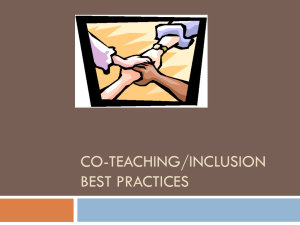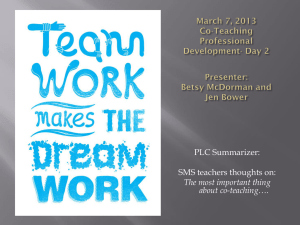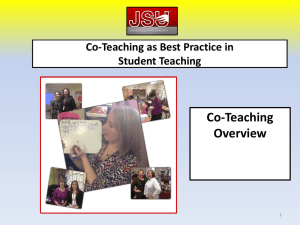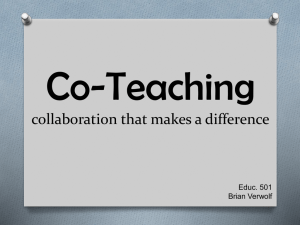Maryland`s Co-Teaching Framework
advertisement
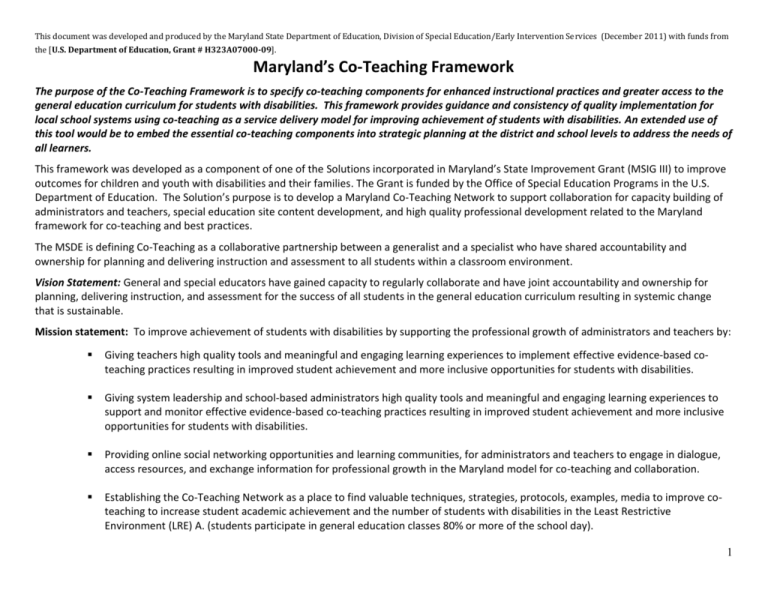
This document was developed and produced by the Maryland State Department of Education, Division of Special Education/Early Intervention Services (December 2011) with funds from the [U.S. Department of Education, Grant # H323A07000-09]. Maryland’s Co-Teaching Framework The purpose of the Co-Teaching Framework is to specify co-teaching components for enhanced instructional practices and greater access to the general education curriculum for students with disabilities. This framework provides guidance and consistency of quality implementation for local school systems using co-teaching as a service delivery model for improving achievement of students with disabilities. An extended use of this tool would be to embed the essential co-teaching components into strategic planning at the district and school levels to address the needs of all learners. This framework was developed as a component of one of the Solutions incorporated in Maryland’s State Improvement Grant (MSIG III) to improve outcomes for children and youth with disabilities and their families. The Grant is funded by the Office of Special Education Programs in the U.S. Department of Education. The Solution’s purpose is to develop a Maryland Co-Teaching Network to support collaboration for capacity building of administrators and teachers, special education site content development, and high quality professional development related to the Maryland framework for co-teaching and best practices. The MSDE is defining Co-Teaching as a collaborative partnership between a generalist and a specialist who have shared accountability and ownership for planning and delivering instruction and assessment to all students within a classroom environment. Vision Statement: General and special educators have gained capacity to regularly collaborate and have joint accountability and ownership for planning, delivering instruction, and assessment for the success of all students in the general education curriculum resulting in systemic change that is sustainable. Mission statement: To improve achievement of students with disabilities by supporting the professional growth of administrators and teachers by: Giving teachers high quality tools and meaningful and engaging learning experiences to implement effective evidence-based coteaching practices resulting in improved student achievement and more inclusive opportunities for students with disabilities. Giving system leadership and school-based administrators high quality tools and meaningful and engaging learning experiences to support and monitor effective evidence-based co-teaching practices resulting in improved student achievement and more inclusive opportunities for students with disabilities. Providing online social networking opportunities and learning communities, for administrators and teachers to engage in dialogue, access resources, and exchange information for professional growth in the Maryland model for co-teaching and collaboration. Establishing the Co-Teaching Network as a place to find valuable techniques, strategies, protocols, examples, media to improve coteaching to increase student academic achievement and the number of students with disabilities in the Least Restrictive Environment (LRE) A. (students participate in general education classes 80% or more of the school day). 1 This document was developed and produced by the Maryland State Department of Education, Division of Special Education/Early Intervention Services (December 2011) with funds from the [U.S. Department of Education, Grant # H323A07000-09]. Collaborative Development and Implementation Stages of the Co-Teaching Framework Personnel Collaborative Development Collaborative Implementation Collaborative Monitoring Collaborative Evaluation Central Office Administration –Facilitate the development of a shared system-wide vision that ensures that schools consider co-teaching as a service delivery method to provide more inclusive programming for students with disabilities –Assist school-based administrators and school Instructional Leadership Teams in their support of the implementation of co-teaching -- Foster a culture of collaboration between general and special educators – Ensure that schools strategically assign an appropriate proportion of general education students and students with disabilities to cotaught classes (no more than 1/3) -Monitor and provide tools to support Instructional Leadership Teams in monitoring the alignment of curriculum, instruction, and assessment in cotaught classrooms –Assess the impact on co-teaching implementation of factors including adequate collaborative planning time, appropriate scheduling of staff and students, and focused, sustained, research-based professional development –Determine system-wide goals and timelines for co-teaching implementation –Determine staffing allocations based on the co-teaching model of service delivery –Consider administrator and teacher skills/knowledge and school readiness when assigning resources (including technology) for co-taught classes -Provide guidelines for scheduling for efficient and effective staff assignment that include adequate collaborative planning time to co-taught classes –Plan system professional development for administrators and school-based staff aligned with the Maryland Teacher Professional Development Standards based on assessed needs that is focused, sustained, and research-based related to co-teaching as an instructional delivery model with the clear understanding that Universal Design for –Provide staff focused, sustained, research-based professional development based on assessed needs related to co-teaching, Universal Design for Learning, and differentiation strategies -Provide staff focused, sustained, research-based professional development specifically related to co-teaching including understanding selecting and implementing the 5 approaches of co-teaching 1- One Teach-One Assist 2- Station Teaching 3- Parallel Teaching 4-Alternative Teaching 5-Team Teaching based upon Friend & Cook, 2007* -Review LRE data to consider if co-teaching as a service delivery method should be expanded to provide more inclusive programming for students with disabilities - Support co-teaching through: --Prioritizing collaborative planning time --Ensuring class schedules accommodate coplanning and coteaching --Ensuring appropriate student grouping --Ensuring parent communication - Assess the impact of system and school-wide co-teaching on student achievement using multiple sources of student-achievement data –Evaluate the effectiveness of the professional development provided in alignment with the MD Teacher Professional Development Standards -Ensure that schools use student data and data collected during the observation process to 2 This document was developed and produced by the Maryland State Department of Education, Division of Special Education/Early Intervention Services (December 2011) with funds from the [U.S. Department of Education, Grant # H323A07000-09]. Central Office Administration Learning and differentiation are expected strategies within the co-taught classroom -Train administrators and school-based staff in the use of the co-teaching tool for monitoring appropriate implementation -Specify measurable outcomes, establish baseline data of current system-wide classroom practice in co-teaching, and interim benchmarks related to co-teaching implementation and student achievement to be collected -Develop procedures for the periodic collaborative review of the system-wide coteaching vision with resources aligned to support the vision – Procedures in place for the periodic, collaborative review of the system-wide co-teaching vision and allocation of resources aligned to support the vision and address barriers to implementation –Implement centralized data collection procedures for established outcomes make recommendations for the improvement of instruction in co-taught classrooms - Conduct classroom fidelity checks for implementation of coteaching, Universal Design for Learning, and differentiation – Evaluate school and system-wide data related to co-teaching as an instructional model and disseminate results related to the specified goals and interim benchmarks with appropriate stakeholders - Plan for ongoing support to ensure sustainability – Ensure that schools use technology and multiple sources of data to improve classroom instruction. Student data will be used for ongoing root cause analysis of student performance that drives instructional decision making -Provide sufficient technology for integration in instruction, progress monitoring and assessment 3 This document was developed and produced by the Maryland State Department of Education, Division of Special Education/Early Intervention Services (December 2011) with funds from the [U.S. Department of Education, Grant # H323A07000-09]. Personnel School-based Administration Collaborative Development -Facilitate the development of a shared school-wide vision that ensures that schools consider co-teaching as a service delivery method to provide more inclusive programming for students with disabilities -Foster a culture of collaboration between general and special educators -Determine school-based goals and timelines for co-teaching implementation -Make staffing decisions based on coteaching model of service delivery including overall size of classroom and proportion of students with disabilities –Ensure scheduling allows for efficient and effective staff assignments to co-taught classrooms –Consider staff skills/knowledge and readiness when assigning teachers to cotaught classes –Consider student strengths and needs when assigning students to co-taught classes –Specify baseline data and interim benchmarks for school-wide co-teaching implementation and student achievement prior to initiation of co-teaching -Create opportunities for leadership, collaborative decision-making, and coplanning Collaborative Implementation Collaborative Monitoring Collaborative Evaluation -Assist school-based Instructional Leadership Team in their support of the implementation of schoolwide co-teaching –Utilize the co-teaching monitoring and support tools with the Instructional Leadership Team to monitor the alignment of curriculum, instruction, and assessment in co-taught classrooms –Assess the impact on co-teaching implementation of factors including adequate collaborative planning time, appropriate scheduling of staff and students, and focused, sustained, research-based professional development – Ensure procedures are in place for the periodic, collaborative review of the school-wide coteaching vision with resources aligned to support the vision and address barriers to implementation –Develop schedule to include coteaching as a service delivery model –Strategically assign an appropriate proportion of general education students and students with disabilities to co-taught classes (no more than 30% with a balance of students with behavioral and academic issues) -Implement school-based data collection procedures for established outcomes -Use technology and multiple sources of data to improve classroom instruction – Use of student data and data collected during the observation process to make recommendations for the improvement of instruction in co-taught classrooms –Conduct classroom fidelity checks for appropriate implementation of coteaching, Universal Design for Learning, and differentiation strategies –Support co-teaching through: *Prioritizing collaborative planning time *Ensuring class schedules accommodate coplanning and coteaching *Ensuring appropriate student grouping *Ensuring parent communication - Assess the impact of system and school-wide co-teaching on student achievement using multiple sources of student-achievement data – Evaluate school and review system-wide data related to co-teaching as an instructional model and disseminate results related to the specified goals and interim benchmarks with appropriate stakeholders 4 This document was developed and produced by the Maryland State Department of Education, Division of Special Education/Early Intervention Services (December 2011) with funds from the [U.S. Department of Education, Grant # H323A07000-09]. School-based Administration -Plan school-wide professional development based on assessed needs that is focused, sustained, research-based professional development related to co-teaching as an instructional delivery model that is aligned with the Maryland Teacher Professional Development Standards -Plan focused, sustained, research-based professional development related to coteaching, Universal Design for Learning, and differentiation to establish teacher baseline data –Review with staff the co-teaching tool and any other tools for monitoring co-teaching for appropriate implementation -Provide staff with focused, sustained, research-based professional development based upon assessed needs related to co-teaching including understanding, selecting, and implementing the (*) 5 approaches of co-teaching 1- One Teach-One Assist 2- Station Teaching 3- Parallel Teaching 4-Alternative Teaching 5-Team Teaching -Review LRE data to consider if co-teaching as a service delivery method should be expanded to provide more inclusive programming for students with disabilities –Evaluate the effectiveness of the professional development provided in alignment with the MD Teacher PD standards -Plan for ongoing support to ensure sustainability –Provide staff with focused, sustained, research-based professional development based on assessed needs related to Universal Design for Learning, and differentiation strategies - Review school LRE data to consider coteaching as a service delivery method to provide more inclusive programming for students with disabilities 5 This document was developed and produced by the Maryland State Department of Education, Division of Special Education/Early Intervention Services (December 2011) with funds from the [U.S. Department of Education, Grant # H323A07000-09]. Personnel General and Special Educators Collaborative Development –Share the vision and commitment to coteaching with colleagues –Engage in collaborative planning with parity –Identify clear roles and responsibilities –Self assess professional development needs related to co-teaching, Universal Design for Learning, and differentiation to establish teacher baseline data –Actively participate in professional development related to; the 5 approaches of co-teaching 1- One Teach-One Assist 2- Parallel Teaching 3-Station Teaching 4-Alternative Teaching 5-Team Teaching and other co-teaching practices, Universal Design for Learning, and differentiation –Establish mutually agreed upon classroom procedures –Design lessons and assessments using Universal Design for Learning and differentiation strategies Collaborative Implementation –Participate in professional development regarding selecting appropriate approaches to coteaching and apply to classroom instruction –Deliver co-taught lessons and assessments incorporating Universal Design for Learning and differentiation strategies –Ensure instruction and assessments provide access to general education curriculum with appropriate accommodations to meet individual student needs –Implement data collection procedures for established outcomes –Address barriers to implementation –Demonstrate shared accountability for planning, instruction, assessment and progress of all students that exhibits shared understandings of student instructional needs Collaborative Monitoring –Complete the co-teaching tool for appropriate implementation of coteaching, and review practices for Universal Design for Learning and differentiation strategies –Conduct ongoing monitoring of student performance –Self-assess periodically the parity in planning and responsibilities Collaborative Evaluation –Analyze student data collected regarding established outcomes, goals and interim benchmarks –Assess impact on instructional delivery and student achievement –Share results with appropriate stakeholders –Determine if intended outcomes have been achieved for lessons implemented –Implement adjustments based upon student performance and needs –Document shared communications with parents – Integrate technology in instruction, progress monitoring, and assessment processes 6



